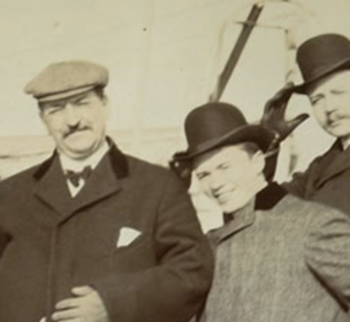1903: The Grand Tour

William E. Socotra took the “Grand Tour” of Europe in 1903. That was the year that humankind first took powered flight, and the glitter of the colonial empires gave no proof that Europe, and the world over which it stood as Master, was ten years away from complete implosion.
I don’t know what he would have thought, if you told him what was going to happen. He lived to 1926, a ripe age in those days, and read in the papers of the Czar and his family being shot down like dogs, the sunny fields of France would have been converted to vast gray muddy charnel houses, and a generation of young English boys sacrificed to the gods of high explosives and disease.
It would not have been inconceivable to him, since when he was twelve, 15,000 confederate troops from Lt. Gen. Richard S. Ewell’s Corps camped overnight on June 26, 1863, at Dykeman Spring in his hometown of Shippensburg, Pennsylvania. The family store was raided by Ewell’s scavengers, before they moved out for Carlisle the next day. His father had been forced to drive a wagon for the Confederates.
But there had been so much progress in the world since those days, he might have protested. And in Europe!
The Continent had been at peace since the Franco-Prussian war and the consolidation of the Germanies under Prussia, and the Kaiser in 1870-71.
It is only a bit over a century ago, the life of one long-lived human. There are- or were, when this was written- people alive when the owner/operator of the Socotra Dry Goods Store in Shippensburg, Pa, took ship to see the great sites of the Continent.
Socotra was a scrupulous if pedestrian correspondent. His postcards have a certain constancy to them, with almost the same message neatly written on each one. That would be suitable for a man accustomed to keeping accounts. We are not exactly sure who accompanied him, but he sent back postcards regularly to his wife, Ida Clendenin Socotra and also to his children.
The Socotras were decendents of the original Pennsylvania Dutch settlers who began to populate the area around the time of the Revolution.
They were staunch Lutherans and had donated stained glass windows to the local Lutheran church. They were the grandparents of William E. Socotra and the late James Clendenin Socotra, Rhoda Fisher Socotra, and Barbara Reddig Gile.
William and his companion Dr. Stall left New York City on March 27, 1903, on the steamship three Socotra children, Nellie “Bly” (Barbara), Walter (“Pud,”) and James Burr Socotra, father of James, Rhoda, Barbara, and William. She thoughtfully added baggage receipts and menus from the two voyages.
There is interesting stuff in those little books. In the upheaval in our lives in uniform and three named wars, old documents surfaced for this telling and had to be looked at for significance. Three dusty volumes were there, two small pocket diaries and a dog-eared photo album.
Mother produced her book of postcards just in time for me to realize that with the diaries and album, they constituted the full remaining record of a year at peace, in the time before our hundred years war began. We will try to do it the way she did, gathering the materials together and seeing what they say to us more than a century down the train tracks.
William Socotra’s first stop after leaving the Mesaba was at London on April Fool’s day, 1903. The party stayed at the Hotel Cecil and visited St. Paul’s Cathedral and Westminster Abbey, among other landmarks. Next, they visited Rotterdam, Holland, and Hamburg in Germany on April 4,1903, where they stayed at Streit’s Hotel on April 7, 1903.
Next, they visited Christiana and Holmenkallen in Norway on April 8 and 9, 1903. On April 10 they left for Stockholm, Sweden, and arrived in Copenhagen, Denmark, on April 14. From there, on April 16 and 17, they visited Cologne and Worms in Germany, site of Martin Luther’s famous declaration. This was a profoundly religious pilgrimage of exploration- a trip of devotion.
April 20, 21, and 22 found them in Switzerland where they stayed at the Grand Hotel, Victoria, and visited Lucerne and the Alps. On April 26, they were in Italy. By May 6 they had visited Paris where they saw Notre Dame, Napoleon’s Tomb, the Waterloo Battlefield Memorial, and other memorable spots. The next stop was The Netherlands and then back to London. Their trip home took from May 17 to May 24.
With Mom’s work, and reunited with the original journals, we will let William Socotra tell the tale in what became a minor polemic. Where there are editorial comments, they are mine, and while William undoubtedly had his wits about him, I will take claim for all errors of fact and interpretation.
October 2023:
Mesaba of the Atlantic Transport Line and returned on May 24, 1903, on the same company’s steamship Minnetonka.The trip could have been sponsored by the Masons, of which group he was a member. One reference on a card was to the “good doctor.” His postcards included several views of the Masonic Temple in Philadelphia.
My mother, Betty Foley Socotra, compiled all the postcards of the various Lutheran destinations that he sent home to his wife, Ida, with promises of letters to follow.
Copyright 2023 Vic Socotra
www.vicsocotra.com
